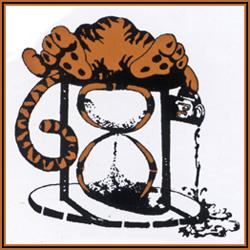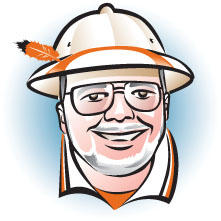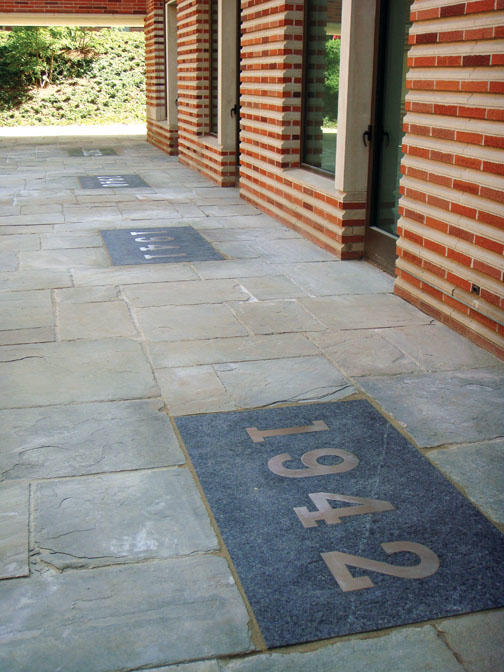Time is on my side, yes it is
Time is on my side, yes it is
You’re searching for good times, just wait and see
You’ll come running back
You’ll come running back
You’ll come running back to me
The Class of 1968 comes to mind each year about now. Reunions brings up the recollection not only of my Keyceptor class (our big brothers, if you will, in the days before women), but also their facility with one of the critical but obscure Reunions skills: establishing a theme. In a sea of orange, black, pseudo-orange, steel gray, and stripey thingees, actual concepts are sometimes hard to come by, but once a class finds one, it can be great fun, whether it be the 1954 hapi coats or the 1967 PJ&B choo-choos. In the case of 1968, the class can lay claim to true greatness by having developed not one but two top-rank themes over the decades. The first relates to the class’s grafted-on imaginary classmate and hero, J.D. Oznot ’68 p’01 s’01. For its 25th, the class hit upon a demented double entendre and became “The Wizards of Oznot!” This was so compelling that the jokes and sight gags wrote themselves, complete with Dorothy and her pals as well as a tribute to the globe-trotting Oznot and his multifarious simulated adventures. Not satisfied with that triumph, the class five years later created a truly universal, extremely powerful theme complete with theme song and global weekly publication, which – once you’ve seen it – you can’t believe never occurred to you. And I think of class members, wherever they’re hanging out (still drinking the brew I gave them money to buy for me as a freshman), because of that idea: “It’s About Time” (sung to the Rolling Stones’ version of “Time Is on My Side”(above) and illustrated with marching Time magazine covers on sticks).

Between finals, Reunions, and Commencement, this is indeed the point in the year we normally dwell on the passage of time quite a lot. Being human (well, maybe a bit tigerish, but still ...), it’s a natural and irresistible thing to do; we see the folks 20 years older and 20 years younger than we are, and somehow we see ourselves more clearly in the giant clockwork of the universe.
It’s that sort of hardwired drive that has led to the somewhat curious practice of stuffing supposedly impregnable vessels with our own detritus, then trying to find a way to ensure that future generations retrieve them somehow and marvel at what swell chaps and chapettes we were back when our gray matter still was holding us back from our digital destiny. Yes indeed, meet The Time Capsule, homo sapiens’ initial attempt at a permanent group Facebook page.
Memorializing your own era goes back a long way, depending in part on what you consider the various purposes of the Egyptian pyramids to be. In the Western world, it long has been tied to a similar concept, the inclusion of trinkets in the cornerstone of an important building, and of course, grade inflation being what it is, progressively less and less important buildings, too. On the Princeton campus alone, there are such important examples as Clio Hall, the new marble version of which in 1890 included a cornerstone full of college and Clio catalogs, the Bric, the Nassau Lit, The Prince, etc.; and Firestone Library, whose stone was laid at the University Bicentennial in 1947 and also includes a copy of The Prince. The cornerstone laying of the U-Store in 1958 doesn’t sound very impressive, but the presence of legendary Princeton alum Bacon Bunn 1907 created an occasion worthy of a copper enclosure containing The Prince (duh), The New York Times, another University catalog, a Bible, and (huzzah!) Your Favorite Periodical. (Alas, PAW’s digital version has yet to be enstoned, to my knowledge.) Dedicated in 1964, the cornerstone of Lourie-Love Hall contained (one of my favorites) the handcuffs with which the lifelong friends were bound at their Class Day in 1922. And the next-door Class of 1942 Hall had a stone that contained more Princes, the class Freshman Herald, and the Nassau Herald.
This brings us to a new variant: Standalone time capsules, sort of cultural cornerstones without the building, are a surprisingly recent conceit, even the term popular only since the ballyhooed Westinghouse capsule from the 1939 World’s Fair (one repository copy of the index for which resides in the University Library). The Class of 1942’s cornerstone inadvertently became a time capsule when the dorm was torn down in 2007. Classmates opened the box, then included a copy of the World War II reminiscences by class members written after the dorm was dedicated, and interred it beneath the new class flagstone in the amphitheater of Butler College.
In the midst of all this, it may not have occurred to you what has always troubled me about these tributes to time (or pleas to eternity, take your pick). Who will care? And why? The Westinghouse capsule in Flushing Meadow, for example, is “due” to be opened in 5,000 years – 5,000 solar years. The Rosetta Stone, in contrast, is 2,200 years old. This is rather nuts, despite the fact that I can readily imagine somebody tripping across the aforementioned index to it in the bowels of Firestone’s C Floor in 7112. That’s different. We all know C Floor will flourish long after mankind has passed from the scene.
There is an elegant answer to this “why?” discomfort, however, embodied in the fresh version of the time capsule provided us by those clever kids in the Class of 1952, with whom we’ve spent some quality time recently in this column (via Dick Kazmaier ’52, Jay Sherrerd ’52, The Class of 1952 Stadium etc.), and also by their grandchild Class of 2002. Five years ago, at their 55th Reunion, the grandpas carefully and surreptitiously assembled a time capsule, comprising mainly records of their activities as undergrads but also, and most important, individual reflections on their experiences over their 75 or so years, and their hopes for their grandkids. Further details were kept secret, and the obligatory impressive sealed tube was invoked to hold the treasures. They are being kept by letter of agreement with the archivist at Mudd Library for the Class of 2002 … to be opened in 2052. Three months before their own 50th reunion, the grandkids are charged with opening and examining the documents, and reporting their findings on their grandpas to their classmates, here in Your Favorite Periodical, and especially to their own grandchild Class of 2052. And I dare say, then creating their own Class of 2002 capsule to be opened by 2052 with the Class of 2102. This is, quite simply, a fabulous and thought-provoking idea, of which all parties can be justly proud.
It’s about time.














No responses yet